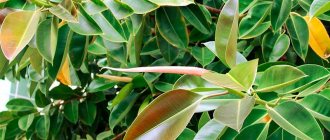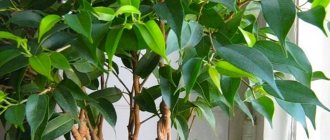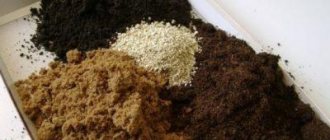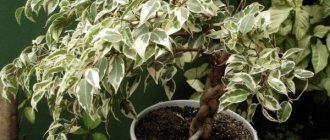Ficus Benjamina is a shrub with thin drooping shoots, oval-shaped leaves and a crown with a pointed tip. May have foliage of different colors depending on the variety.
Dear readers! For you, we have created communities on social networks in which useful articles and interesting ideas are published several times a day! Subscribe and receive useful content in a convenient format!
This is interesting: Ficus benjamina, along with plants such as Sansevieria, is one of the best indoor filter plants. Ficus trees have been proven to be very effective in absorbing formaldehyde, toluene or benzene. Some of its varieties are especially prone to air filtration and increased humidity.
In its natural environment, ficus benjamina can grow up to 30 meters tall. In houses the maximum height is 2-3 meters. But this is also enough to form a beautiful and powerful tree abundantly covered with greenery, which will invariably decorate any modern or classic interior.
Caring for Ficus Benjamina after purchasing from a store
First of all, after purchasing, it is important to start replanting the young plant, since very often the purchased soil is quite poor in terms of nutrients and minerals in its composition.
After purchase, the flower must be replanted
One of the characteristic features of most varieties of Ficus Benjamin is rapid growth . Therefore, you should carefully choose a permanent place for it with indirect sunlight, but sufficient diffused illumination. In the summer, it is advisable to frequently water the bush and spray the leaves. If all the conditions suit the ficus, it will quickly turn into an adult tree, pleasing to the eye.
In general, Ficus Benjamina is indeed a very unpretentious plant. But at the time of purchase you should still pay attention to the appearance of the sprout. Especially if the ficus is still small in size, with only two leaves:
- Firstly , most of the leaves (in particular the upper ones) must be healthy and undamaged.
- Secondly , there should be no traces left by pests on the back side of the foliage.
- Thirdly , the soil should not be too flooded, but not too dry.
With the right and competent choice, you definitely won’t have to revive the purchased tree, that is, you won’t need to do any extra work.
The best stores, for example, offer plants in pots with plenty of room for growth and a label with the name of the variety, care features and growing tips.
Description and photo of ficus Benjamin Natasha
Ficus benjamina Natasha is considered an evergreen plant from the Mulberry family . Has a lot of features:
- a system of roots that grows so much that they protrude from under the ground;
- rounded trunk of a light brown hue;
- branches and shoots are usually branched and drooping;
- The leaves have sharp tips and a smooth surface.
Interesting! The plant does not bloom in apartments or houses.
This is only possible under natural conditions. Unlike other varieties, ficus Natalie does not require special maintenance conditions. The main thing is to water and feed it correctly, as well as choose suitable soil .
The only requirement is to protect it from direct sunlight.
The secret of the popularity of the green pet lies in the ability to give the crown any shape. It all depends on the owner’s imagination.
Growing conditions
For the most part, standard indoor conditions work well for growing ficus benjamina. Particular attention should be paid perhaps to lighting and maintaining humidity - a flower is almost always particularly demanding about these characteristics.
Temperature
The best temperature for ficuses in the summer should not significantly exceed +24-25°C. The optimal range is considered to be +19-23°C.
In winter, the best temperature will be +15-16°C. Although you can often hear that ficus trees can easily withstand severe cold weather. True, only for a short time.
Air humidity
Maintaining soil and air moisture is an important quality that must be carefully and carefully monitored.
Ficuses love high humidity. This is why they need to be watered every day during the summer months. The greens should be sprayed periodically through a sprayer.
Advice. Ficus benjamina, for example, would benefit from a good shower in the bathroom. Firstly, this will create sufficient conditions for soil moisture and greenery, and secondly, get rid of pests such as spider mites or scale insects and their nests.
In autumn, and then in winter, moisture should be reduced, gradually increasing the frequency of watering to once a week. In the coldest decade of the year, you should also not spray the leaves with a spray bottle.
Working heating, which dries out the air in the rooms, can cause great inconvenience in winter. Then it is recommended to increase the humidity. The best way is to use an automatic humidifier. Or you can give preference to the old proven method - leave a saucer of water next to the ficus.
Lighting
In terms of lighting, ficus benjamina does not like direct sunlight. Otherwise, the leaves will quickly wither or even suffer from heat burns. As a last resort, exposure to non-aggressive sun at sunrise or sunset is allowed.
But ficus bushes love diffused natural light. In the conditions of central Russia, there is enough daylight only in summer. In other seasons, additional lighting with artificial lamps may be required. But only if there is a desire to quickly grow a tree to a large size.
Where to put a flower pot
It is believed that the ideal location for a pot of Ficus Benjamin is windows and balconies facing east or west.
The south side can be dangerous because the sun stays there most of the day. This will be very harmful for the foliage.
On the north side there may not be enough light, which is why the bush will grow weakly and generally get sick often.
During the summer months, it is recommended to move ficuses to fresh air. A good place in the apartment can be a balcony (for the whole season). And in the southern regions you can even take the flower outside, but place it in a shady place.
It is better to place the ficus on a western or eastern window
When the tree grows to a large size (up to a maximum of 2-3 meters), it can be permanently left in the corner of the room, but choose the location in such a way that the nearest radiators are at least 1.5 meters away.
What does it look like in the interior?
Ficus benjamina is an evergreen plant that looks equally good in the interior in both winter and summer. The bush looks especially impressive when mature, enriching an indoor greenhouse.
The plant perfectly complements modern types of interiors. The main visual qualities of the ficus are the special shape of the trunk, which is an interweaving of woody roots, and a lush, neat crown. Small decorative varieties that do not grow more than 20-30 cm are perfect for decorating living rooms and kitchens.
Ficus benjamina in the interior
How to care
This plant is considered one of the easiest to grow. But in order for it to please you with a healthy appearance, fresh bright leaves and active growth, you need to follow certain rules when caring for it.
Temperature and lighting
Ficus Benjamin, especially its variegated varieties, like most plants native to warm southern regions, loves light. Although he will be able to come to terms with his absence, but remaining in the shadows, he will grow very slowly and be stunted. It must be borne in mind that direct sunlight is just as harmful to this plant as lack of lighting. They cause burns and yellowing on the foliage. Therefore, the best place for Ficus Benjamin and caring for it is near a window or balcony with soft, diffused light.
Despite the fact that the Benjamin tree quickly “gets used” to the place and does not like changes, it is advisable to take it out into the fresh air (loggia or balcony) in the summer. In gratitude, it will begin to grow faster and fluff up. The optimal air temperature for Ficus Benjamin is in the range from 18 to 30 degrees, when at night it drops to 15-16 degrees, return the plant to the room.
Watering and humidity
The original tropical inhabitants of ficuses love humidity no less than light, but do not require frequent watering in low light conditions, typical for home cultivation. In summer, the roots drink water more intensely, the soil dries out quickly enough and the plant can be watered every 4-5 days. If the soil in the pot remains wet, you should not water the ficus. In addition, in order for the tree to feel comfortable, its leaves need to be wiped free of dust.
Spraying a ficus with water at room temperature from a spray bottle is never a bad idea.
In winter, watering once every 10 days is usually sufficient. And in order to provide the plant with comfortable conditions when the heating devices are running, you can use an electric humidifier in the room or arrange a warm “tropical” shower from a spray bottle two or three times a week, having first wrapped the pot with the tree in a plastic bag and tied it around the base of the trunk.
Evergreen tropical plants do not have a pronounced dormant period, so throughout the year they need to be provided with approximately the same lighting, nutrition, heat and humidity.
Fertilizers and fertilizers
At the end of March and beginning of April, Ficus Benjamin awakens to growth. At this time, you can begin to practice pruning, replanting and start feeding. Its frequency depends on the rate of growth, which begins in the spring, picks up pace by mid-summer and begins to decline by autumn. So, in March and April, fertilizing is carried out once a month, starting from May - once every 3 weeks, from mid-June to September - once every 2 weeks.
Ficus plants respond well to all organic fertilizers: ash, chicken manure, sapropel, as well as universal mineral mixed fertilizers for home flowers and plants. Starting from mid-November, feeding is stopped and the plant is allowed to rest. But if the apartment has ideal conditions for the ficus in terms of light, temperature and air humidity, you can continue to apply fertilizer at half the usual rate once every 2 months.
Features of care at different times
As with any indoor plant, Ficus Benjamin, depending on the season outside, requires different conditions in the room where it grows.
in spring
Thus, this flower often greets spring sluggish and exhausted. The foliage looks weak, sometimes curled and withered. You can get rid of this problem with the help of fertilizing. It should be started already in March, increasing the frequency of application by the end of spring to 2 times a month.
It is better to give preference to special purchased solutions for ficus plants. After all, ficus bushes especially acutely lack minerals in the spring for normal growth. Accordingly, they should be intensively applied to the soil, choosing first of all fertilizers rich in minerals.
Spring is also the time of year when it is best to replant indoor plants into larger containers. While the ficus is young, the procedure is carried out every year due to rapid growth - a feature of all Benjamin ficuses. After 3-4 years, the bush gradually slows down its growth. Then it is replanted every two years. A fully grown ficus does not need to be replanted - it is enough for it to add the top layer of soil along with fertilizer every spring.
In spring, ficus needs to be fed for better growth.
In summer
The main, most rapid growth of Ficus Benjamin occurs in summer. If the conditions are particularly good, sometimes you can even achieve flowering and fruiting. But this happens very, very rarely in captivity.
When the temperature outside the window rises too high, you will have to save the flower from drying out. Watering is then carried out every day. For foliage, you will need to give it a light cool shower using a sprayer.
In the summer, it would be a good idea to continue feeding the plant at the same frequency as in the spring.
The warm season, especially the last months of summer, can be used to propagate ficus trees. For these purposes, the cutting method is best suited. The healthiest and most beautiful upper shoots with at least 2 formed leaves are suitable as cuttings.
in autumn
The autumn period means gradual preparation for winter. All care comes down to completely eliminating fertilizing, gradually starting to reduce the frequency of watering, and choosing an optimally lit place after summer.
in winter
In winter, Fucus Benjamin is in a state of sleep. Therefore, it is not recommended to water it frequently (best frequency: once every 10 days). The only peculiarity is related to the fight against dry air from the batteries. To do this, it is best to additionally humidify the air with automatic devices or leave saucers of water on the windowsill.
Planting ficus benjamina in a pot
The operation is very responsible. An incorrect substrate or container volume, lack of drainage, or deepening of the root collar will certainly cause the leaves to turn yellow and fall off. If the situation is not corrected quickly, the plant will suffer for a long time and may die.
Planned transplantation is carried out only in the spring, emergency transplantation - regardless of the season.
Requirements for substrate and containers
Most ficuses, including Benjamin, need a pot of regular shape. It can be made from unglazed clay or plastic. Airtight materials are not suitable.
Buying a beautiful branded pot that matches the interior of your apartment can result in the death of the tree. It can be used as a flowerpot, and a regular plastic container can be placed inside. Clay pots are decorated with jute, braided cords, or other methods.
Ficus benjamina loves soil:
- loose, permeable to water and air;
- with a neutral or slightly acidic reaction;
- moderately fertile, only for bonsais can we recommend planting in soilless mixtures.
Even experienced gardeners do not refuse ready-made substrates. For beginners, it is better to use only them; choose not a universal one, but a specialized one designed for ficus plants. The components are ideally selected, there are starting fertilizers with the correct proportions of macro- and microelements, sufficient to nourish the tree in the first 1-2 months after planting.
How often to replant ficus benjamina
It is recommended to move the flower into a pot with a diameter 2-3 cm larger than before:
- the first 3 years of life - every spring;
- in the future - once every 2-3 seasons;
- For tub specimens, change only the top layer of the substrate.
But this is a rule that requires adjustment depending on the condition and speed of development of Ficus Benjamin, and not an axiom. You can replant the crop only when the old pot becomes too small, otherwise it is not only meaningless, but also harmful to the plant. The signal is:
- roots growing through the drainage hole;
- slower growth, small leaves, the trunk stops thickening with regular feeding;
- the substrate began to dry out too quickly;
- If ficus benjamina is taken out of the pot, the lump almost entirely consists of tangled roots, behind which the soil is not visible.
Reasons for emergency transfer:
- the substrate has become sour due to waterlogging and smells bad;
- the surface of the earthen clod and the walls of the pot are covered with a whitish coating - salts released due to watering the ficus with hard water, excess, incorrect combination or low quality fertilizers;
- the root began to rot;
- During the previous transplant, a substrate that was too acidic, alkaline, contaminated, and impervious to water and air was used.
Transshipment
Benjamin's species is a tree-like ficus. Even with a planned transplant of a healthy plant, any damage to the root may cause leaves to fall off and require long-term treatment. Therefore, they try to transfer the crop without destroying the earthen lump:
- Ficus benjamina is carefully removed from the pot.
- Remove the old drainage, shake off the top layer of soil, and free some of the lateral and lower roots.
- Fill the new container 1/5 with drainage, add a little fresh substrate.
- An earthen ball is placed in the center so that the root collar of the Benjamin ficus is at the same level as in the old pot.
- Fill the free space with soil, compact it, and water it.
Transfer
The operation involves partial or complete removal of old soil. For Benjamin varieties, this is stress, from which the tree takes a long time to recover. Careful care will be required for a month or longer.
It is recommended to refuse transshipment in favor of replanting an adult ficus only if the root has rotted, soured or the substrate has become infected.
Subsequence:
- The plant is taken out of the pot, the earthen ball is inspected, assessing the damage.
- Use a sharp stick to remove the old soil.
- If it is removed completely, the root system is washed.
- The processes are stripped back to healthy tissue.
- Disinfect, if necessary, soak in a fungicide solution.
- Allow the wound surfaces to dry until callus forms.
- Plant in fresh soil as described in the previous chapter.
Care after transplant
Ficus benjamina is placed in the shade, not watered, and sprayed with warm water several times a day. They monitor its condition and transfer it to a permanent place when the rudiments of new leaves appear. They begin to feed no earlier than a month later.
Replacing the top layer
It is difficult to replant or replant tubular specimens or tall varieties of Benjamin with trunks intertwined into a hedge or trellis. Especially if the total weight of the pot with the plant requires the collaboration of several people. It is customary for them to change the top layer of soil by 2-3, maximum 5 cm.
How to care for young and adult plants?
Young ficuses are most sensitive to three aspects: light, mineral content in the soil and air/ground humidity. These characteristics are very important for optimal growth and disease resistance.
Accordingly, you need to choose a well-lit place in the house, but without direct sunlight. The second point is to choose the most suitable watering regime, for which the first time is to monitor the soil moisture (it must be deeply moistened) and combat dry air.
Finally, in the spring, don’t rule out at least occasional fertilizing to enrich the soil in the pot with the necessary minerals.
As a rule, an adult plant survives some unfavorable factors more easily, and in general is well adapted to the surrounding room conditions. The perennial ficus bush practically does not need to be replanted; you can fertilize it only 2-3 times in the spring, and this will be enough, since the plant hardly grows.
Even the location of the pot with perennial ficus does not need to be changed at different times of the year.
Varieties and varieties
Ficus benjamina is very popular among indoor plants. But its different varieties can differ significantly from each other in appearance and maintenance conditions. But in all cases, one or another variety will certainly decorate any home greenhouse. So all that remains is to choose the appropriate ficus based on your own preferences.
Natasha
One of the most common varieties of Ficus Benjamin. Many gardeners love it for its ability to give branches any direction (using a guide wire). Also, the young plant has a flexible trunk, which makes it possible to create intricate interweavings from several plants.
The Natasha variety has small leaves of bright green color (only mature foliage is painted in dark green tones). Caring for the variety is pleasant and easy. It is enough to spray it a lot - up to 2 times daily - and also try to shake the crown so that the densely growing greenery is blown.
Kinky
An excellent variety for purifying indoor air (one of the leaders among all ficus trees). In addition, Ficus Benjamin “Kinky” looks very elegant, representing a decorative tree up to 40 cm in height.
The main external distinguishing feature of the variety is the special color of the leaf. Their edges are painted with a variegated white (sometimes gray) stripe.
The peculiarities of care consist only in periodic correction of the crown so that the ficus does not grow too much and is formed into a neat flower arrangement.
Daniel
The variety "Daniel" is rightfully classified as a fast-growing variety. It is often recommended to be chosen by those who want to grow an ornamental tree of 2 or more meters in just a few years.
Externally, this ficus is close to the classic concept: it has monochromatic leaves of a slightly elongated shape, a standard stem and a rather sparse crown. But it gains height quickly - up to 30 cm in one season.
In terms of care, the Daniel variety is considered one of the most resistant. It even easily tolerates a place in partial shade, but in this case it significantly loses its growth rate.
Exotic
A very common variety of Ficus Benjamin, which is used for street landscaping in South Asian countries.
The shape of the bush is distinguished by a dense crown structure, which gives it a decorative and neat appearance, large leaves, and interesting interlacing of the trunk. At home, the tree grows small in size, making it ideal for decorating a bonsai-style room.
When caring for the “Exotic” variety, you can pay less attention to the lighting of the plant, since it grows even in the shade. But you should water it carefully. So, before the next watering, you need to wait for the soil to dry completely, and also remove excess moisture from the leaves, because it is poorly absorbed due to the dense structure of the leaf blades.
Starlight
The Starlight variety is very demanding in care. For it, you need to create almost ideal conditions in terms of lighting (bright, but not direct sunlight). You will also have to carefully monitor the frequency of watering.
On the other hand, in return you get an interesting-looking bush, with large white stripes and spots on the leaves. Some leaves are completely devoid of green pigment. Of course, such a tree catches the eye in any greenhouse, especially against the backdrop of standard flowers and plants.
Ficus Benjamin "Starlight" is grown on window sills, in flowerpots, on tea tables, coffee tables, etc.
Baroque
Ficus variety "Baroque" is a real pearl among ficus trees. Its main distinguishing feature is the special shape of the leaves. They curl across the spine of the leaf, which is why they form not boats - the usual and familiar shape - but a kind of donuts or curls. The general structure of the bush is more focused on wavy, unique shapes.
Many gardeners are proud to have Ficus Benjamin "Baroque" in their collection. But caring for him is not easy. It is very demanding on temperature (not lower than +20°C), air humidity and watering. However, in terms of illumination, it can also tolerate light partial shade. The main thing is that the room is warm.
The bush grows extremely slowly and reluctantly. Therefore, it is often used as a decorative decoration.
Lovely
The “Lovely” variety is quite demanding in terms of lighting. But it looks unusual - its leaves are variegated, with a unique pattern of white stripes and spots along the entire edge of the leaf.
This ficus is best used as decoration: it looks perfect on a coffee table, next to a sofa or armchair, complementing the surrounding interior.
Esther
The “Ester” variety is found quite often in homes, and is valued primarily for its amazing unpretentiousness. In fact, for this ficus bush you only need to practice fertilizing occasionally and develop an ideal watering scheme.
The ficus looks quite ordinary; it grows a dense crown of light green elongated leaves.
Popular varieties
"Baroque" ("Boucle")
The leaves are light green in color, curled, about 6 cm long. Due to the unique shape of the leaf apparatus, it looks good on a windowsill or near a window on a stand or table.
Baroque
"Golden King"
The leaves are green, their edges are golden.
Golden King
"Bushy Prince"
The leaves are bright green in color and oily in appearance.
Bushy Prince
"Viandi"
The plant forms a winding trunk.
Viandi
- "Golden Monique" has green leaves with dark spots.
- "Gold Princess" - leaves of light green color interspersed with a dark green hue.
- "Lakia" - green-white leaves.
- "Daniel" has dark green leaf blades. Looks impressive in landscaping.
- "De Gantelle" has green and white leaves.
- “Curli” - the plant looks original due to the combination of dark green and cream shades in the color of the leaf blades.
"Midnight Lady"
The leaves are dark in color.
Midnight Lady
"Monique"
A beautiful plant with dark green leaf blades.
Monique
- "Ester" - the plant has leaves of a golden hue.
"Natasha"
The small leaf blades are green in color and have a white edge interspersed with a golden hue.
Natasha
- “Profit” - the color of the leaf blades is green and white.
- "Samantha" - leaves are grayish-green in color and have a thin edge.
Kinky
This plant perfectly purifies indoor air and absorbs harmful compounds. In many countries, ficus preparations are used to treat uterine tumors, furunculosis, osteochondrosis, and radiculitis.
In Thailand, this plant is considered sacred. For its owner it attracts happiness and good luck. In China, they believe that ficus creates a cozy and pleasant atmosphere in the room. There are signs and superstitions that if a woman wants to get pregnant, she must place a ficus tree in the bedroom.
Does Ficus Benjamina bloom?
Flowering ficus Benjamin in captivity is an extremely rare sight. It is usually achieved in special greenhouses, where ideal conditions are maintained that replicate the plant’s natural habitat.
Ficus flowers are far from traditional ideas. They are called syconia and are small balls with a small hole, hollow inside. They can only be pollinated by insects that live in tropical latitudes. The flowers differ from variety to variety, but are mainly painted in bright colors: white, yellow, orange.
The fruits of ficus are inedible, they look like small red berries (as they ripen they change color to burgundy).
Ficus benjamina flowering
In fact, due to difficulties with pollination, it is possible to achieve flowering of ficus at home, but it is very difficult. But growing fruits, and even with seeds, is a truly rare and almost impossible task in captivity.
Signs associated with Ficus Benjamin
There are a number of signs and beliefs associated with the Benjamin ficus. But the reputation of the plant in different countries is radically opposite. Some people suggest that such a flower can have a bad effect on the personal life of its owner, driving men away from her home. If the ficus is in the house of a married woman, her marriage may fall apart. But in eastern countries - Thailand and China - this ficus is revered as the guardian of family happiness.
Decorative foliage plants Indoor plants
Transfer
Usually, there simply cannot be any difficulties with the transplant. The best method is transshipment while preserving the soil around the roots . This will significantly reduce stress for the flower.
- The first transplant is recommended immediately after purchase (especially if the ficus is sold in a temporary pot).
- Until the ficus reaches 3-4 years of age, it needs to be replanted every spring into a pot 3-5 centimeters larger in diameter than the previous one.
- Afterwards you should look at the growth of the bush. If formation occurs quickly, then transplantation can also be carried out annually.
- It is generally not recommended to replant an adult tree, but simply add a new layer of fertile soil every spring along with fertilizing.
In general, the conditions for transplanting ficus trees are quite standard and should be familiar to even inexperienced gardeners. And given the relative unpretentiousness of ficuses and resistance to stress, problems rarely arise in the process.
Ficus benjamina transplant
When and how to transplant to another pot
It is best to transplant Ficus Benjamin at home in March or April. Young specimens need replanting annually, and adults – once every three to four years. In between, remove the top layer of substrate from the pot and replace it with fresh one.
This may be interesting: Rules for caring for Dieffenbachia at home
Replant your ficus as follows. Take the flower out of the old pot with a lump of earth and, using the transfer method, place it in the center of the new pot, where a layer of drainage and a layer of new substrate have already been laid. Fill the voids between the plant and the walls of the pot with soil, shaking the pot slightly. If the room is hot, lightly water the transplanted ficus and spray its crown with a fine spray bottle. If the room is cool, it is better not to water the transplanted plant for a couple of days.
Young Ficus Benjamin bushes should be checked frequently for rapid root growth. To do this, turn the pot over and look at its bottom. The roots may already be peeking out of the drainage holes. If so, rejoice, you got a fast-growing specimen. Without waiting until next spring, you will have to transplant it into a new, slightly larger pot.
What kind of pot do you need?
Choose a clay or ceramic pot for ficus benjamina. The new pot should not be too bulky, just a little larger than the old one. Then the root system of the flower will quickly cope with the development of the entire volume of new soil, and the flower will more easily take root in the new place. Let us immediately pay attention to the size of the pot for creating ficus bonsai - it should be wide and shallow.
Suitable soil
The natural habitat of Ficus Benjamin is the humid tropics with their characteristic moisture-absorbing nutritious soil. When growing indoors, you need to buy or prepare a substrate yourself that is similar to its natural composition. For Ficus Benjamin, purchased soil for decorative foliage plants is suitable. You can use the soil for Mulberry plants or Palm trees. Note that ficus plants are not very picky about the composition of the soil. It is only important that it is nutritious, breathable and has neutral acidity. Self-prepared soil should be like this: a mixture of peat, garden soil and sand in equal parts. You can add a little wood ash to eliminate the acidity of the soil. Adult specimens require a denser substrate, so turf soil and humus should be added to this soil composition.
Do not forget! At the bottom of the pot there should be a good layer of expanded clay or other drainage material with the addition of pieces of charcoal.
Landing
It is best to plant cuttings or small sprouts of ficus with a root system in specialized soil for ficus, which is popular in garden stores.
But you can prepare the mixture yourself. To do this, it is recommended to maintain a ratio of 2:2:1:1, using respectively: deciduous soil, turf soil, coarse sand, peat. The main qualities of soil for ficus benjamina are weak acidity and good ability to transmit moisture deep into the soil.
Reproduction
The most optimal way to propagate Ficus Benjamin is by cuttings . To do this, shoots with at least 2 well-formed leaves are selected on an adult plant. The lower edge of the cut branch should be wrapped in a damp cloth, bandage or cotton wool, and then the sprout should be placed in water.
After about 2 weeks, roots begin to grow. At this point, the ficus sprout needs to be transplanted into a bud or sand.
At first, it is important to create greenhouse conditions with high temperature and humidity. To do this, the pot is covered with polyethylene, but is ventilated briefly every day.
When new ficuses are established in the ground, they should be permanently transplanted into pots with a diameter of 9 cm. The soil used in them is the same as for adult ficuses.
Such sprouts should be watered carefully, trying to maintain a balance, not too moistening, but also not drying out the soil. When spraying the ficus with a sprayer, it is a good idea to carefully remove drops of water from the surface of the leaves.
Ficus cuttings
Pruning and crown formation
It is recommended to trim Ficus Benjamin, as this is the only way to form a correct and attractive crown.
The process can be called simple. The thickest branches, with 2-3 buds above the leaf, are removed.
The procedure is repeated as necessary, but the average frequency is once every 3-4 years.
Secrets of the masters. The most experienced specialists grow several young ficus plants next to each other, gradually weaving the trunks into a pigtail. When the plant grows, the wooden trunk develops a unique, unique topography.
How to braid Ficus Benjamin Natasha
Weaving is subject to a number of rules:
- It is better to take 3 young trees of the same height.
- To obtain a beautiful weaving, the trunks must be half lignified.
- The minimum height of the shoots is 13 cm.
- It is recommended to tie the trunks at an angle of 45°. Bamboo sticks are used as support.
There are several types of weaving. This is a pigtail (as in the photo), a spiral, a lattice, a hedge.
Pinching
Pinching is a necessary step in the later periods of growth of Ficus Benjamin. Its purpose is standard - to stop growth in height and begin the formation of side shoots.
The apical shoots are gradually removed (by the way, they can later be used to grow a new plant by cuttings). Above the leaf, which will remain the top of the crown, a shoot with 4-5 buds is wrapped down and fixed on the trunk (with a rope, rubber band, etc.). Over time, this part will begin to dry out. Eventually, it can be removed with a sharp knife. The trunk must be cut obliquely.
After this, the ficus will stop growing upward.
Carefully! During the work, it is important to remember that ficus juice can be toxic to the skin or irritate human mucous membranes. You should work with gloves.
It is recommended to sprinkle the sections with charcoal to quickly stop the secretion of juice and speed up healing.
Watering
Watering Ficus Benjamin
Like all plants from the tropics, Ficus Benjamin loves good watering. In winter and late autumn, it is enough to water the flower once every 7-10 days.
In spring and summer, during the period of the most rapid growth, you can moisten the soil even every day. In addition, it is advisable to periodically spray the entire bush with a spray bottle and occasionally rinse the entire flower along with the pot in the shower.
Top dressing
In terms of feeding, it is better to give preference to specialized mixtures for ficus plants. Acceptable analogues are fertilizers rich in minerals.
The peak of fertilization occurs in early spring, when the flower needs to be awakened after winter. Approximately the same intensity is maintained until the end of summer.
It is better not to fertilize during the cold season. But the most important thing is to monitor the condition of the bush and, if necessary, enrich the mineral composition of its soil, even despite the established season.
Diseases and pests
In general, Ficus Benjamin is considered a very resistant plant to diseases and pests. But some of the most common problems are also characteristic of it.
- Ficus leaves are often susceptible to sunburn. The reason is too aggressive direct sunlight. Ficus loves light, but only diffused light.
- High humidity, which the ficus needs so much, is the primary factor for the appearance of spider mites and scale insects. Prevention of their reproduction consists of periodically washing the flower in the shower.
As it became clear, most diseases are quite easy to fight. Cases of severe diseases that lead to the complete death of the plant are very rare.
Sooty fungus on ficus leaves
Common mistakes
Wrong place
Ficuses love shade; this is their natural habitat. But there should be enough diffused, soft light.
No trimming or pinching
Ficuses should form a crown. This is important in the later stages of growth to create a truly beautiful plant. Therefore, you will need to trim the top shoots and pinch out the most vigorous shoots.
It is also recommended to rotate the bush, as it can stretch towards the sun, causing it to appear asymmetrical.
The leaves are turning yellow
Perhaps the yellowing of leaves on Ficus Benjamin is the most common problem. One thing is certain - the reason for this appearance is due to improper watering or insufficient air humidity.
However, you need to be careful: if you overwater the flower, the bush will not recover, but on the contrary, it will shed most of the affected foliage.
Popular varieties with photos and names
There are several varieties of Ficus Benjamin, each of them has a special appearance.
Exotic variety
This is a compact and unpretentious plant with dark green leaves with wavy edges. It is recommended to start getting acquainted with Ficus Benjamin with this variety due to its unpretentiousness.
Danielle
Very similar to the exotic variety. Its leaves are quite large (6 cm) and dark green.
Variety Monique
A very common variety, which is divided into two similar types: simply Monique and Golden Monique, the leaves of which are characterized by a golden hue. This variety is more capricious than Daniel and Exotica.
Variety Reginald
This is the most popular variety, highly valued for its variegated leaf color. Small light green spots are randomly scattered on a light green background. The edges of the leaves are smooth, not wavy.
Variety Kinkye
The color of the leaves is characterized by a combination of a dark green background and a light green edging. The leaves are quite small, not exceeding 5 cm. It is this variety that often needs pruning and shaping. You can create a fancy figure from it.
Variety Nicole
Winner for uniqueness of pattern. The light green edging here is much wider than Kinki's. This contrast of dark and light shades looks attractive.
Variety Starlight
The leaves of this plant are almost completely white, it looks very impressive. Due to a lack of chlorophyll, the plant needs intense lighting.
Barok variety
Answers to popular questions
Why doesn't it grow well?
Poor growth of any ficus is often associated with a lack of daylight. Another reason lying on the surface is the lack of necessary minerals in the soil. Finally, too dry air is also a common problem in most rooms where ficus grows.
Why does it wither?
The wilting of ficus foliage is a natural process that occurs every spring. Abundant fertilizing after wintering will help reduce the wilting time.
On an adult plant, leaves can wither at any other time of the year. Unfortunately, the reason almost always lies in the excessively dry air in the rooms. Automatic humidifiers or placing dishes with water next to the pot to naturally evaporate moisture will help get rid of this.
Why do the leaves fall
In general, moderate leaf loss is normal for ficus trees. If a flower loses a lot of green cover, and does so abruptly, then the environmental conditions are unsuitable for it.
You should check whether the ficus is bothered by drafts and how much the temperature in the room has changed. It is possible that leaf fall can be corrected in a timely manner if the plant is returned to its previous conditions.
Conclusion
Ficus Benjamina is a very popular indoor plant. Of course, it is valued for its two most important qualities - unpretentiousness and ease of care. Because of this, it will almost certainly be possible to grow a beautiful tree even without much experience under your belt.
Experienced gardeners can easily create entire compositions of ficus plants in their greenhouse, using the possibilities of weaving trunks into an interesting braid, forming a beautiful and extraordinary crown, and sometimes even achieving exotic flowering of this tropical plant at home.
Features of watering
For gardeners who grow Ficus Benjamin, caring for it at home is not fraught with difficulties. This is also true for the irrigation system.
It is only important to remember that the plant does not respond well to dry soil, although the soil should not be over-moistened. To check, just use your finger to check the condition of the ground at a depth of 3 cm.
If both the top layer and the deeper levels have dried out, then you need to water the plant, but if there is moist soil at a depth of 2-3 cm, it is advisable to refrain from additional moisture.
In summer, the plant is usually watered every 3-4 days, but in winter you can limit yourself to weekly watering. Although you should not leave the ficus for a long time without watering, otherwise it will simply shed its leaves. Use soft water. It should first be boiled or allowed to stand. Temperature - no higher than room temperature.
Overmoistening the roots is detrimental to the flower. If you water too often, you should not be surprised that your ficus benjamina will fall off. It is recommended to leave a shallow tray, which must be regularly emptied of excess water.











